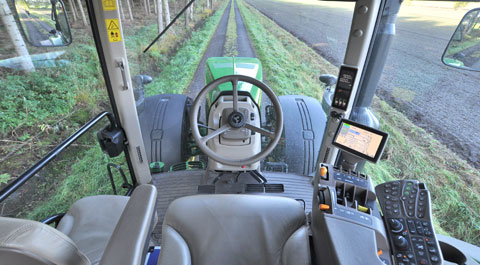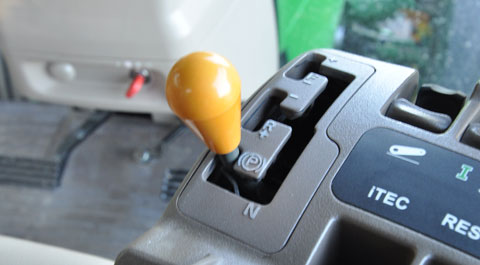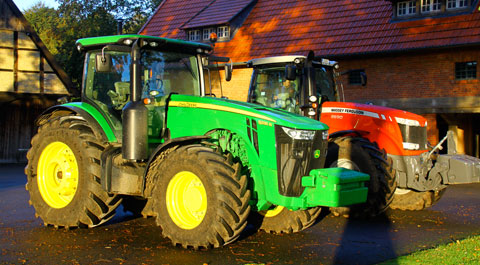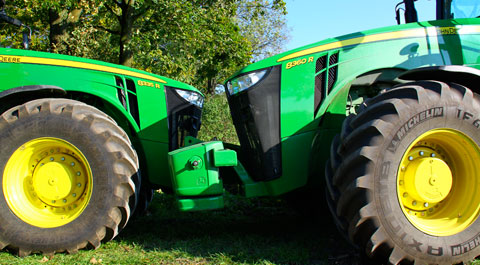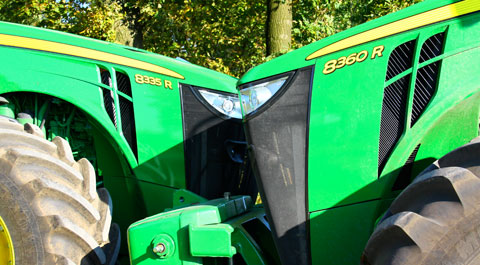Top-end tractor test: John Deere 8335R
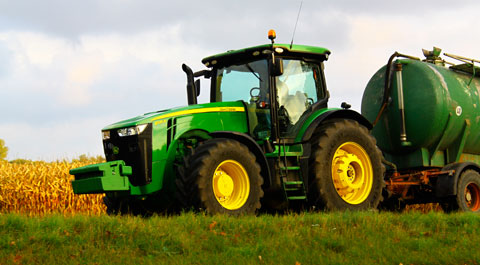
At certain points through the measurement curve for partial engine loading, the engine burnt more diesel than its competitors. But with a DPF the Deere needed no AdBlue and so came out pretty well in the end.
The full powershift transmission is spartan in terms of the number of gears on offer (16F x 5R) and having only three steps in the autoshift programme is a disappointment, as is its top speed of 40kph. But in driving comfort and ergonomics the “small” Deere is among the best on test. Base price £179,175.
The climb is steep into the Deere cockpit (five steps) and the wide-swinging door is difficult to close. We liked all the stowage space, especially the robust rubber box on the floor.
Nearly all the controls in the cab are concentrated on the well-designed armrest. No multifunction joystick is available, but experienced John Deere drivers won’t see this as a disadvantage.
The cab is well finished with a noise level reflecting the test group average at just under 74dB(A). The test tractor came with a luxurious leather-upholstered seat and there’s also a very comfortable leather-covered passenger seat.
There is no dashboard instrument panel as such. Instead, a display in the right-hand pillar provides the key information (fuel, temperature, gears and so forth) although reading this was difficult in strong sunlight.
The compact touchscreen computer terminal on the armrest gets top marks for brilliant screen quality, simple fingertip operation and keys for direct access. Touch an icon on the display and it takes you straight through to the relevant settings page.
Menu operation is clear and adjustments can be made by a rotary dial or the touchscreen. Using a password allows tractor functions to be locked via the terminal.
Looking ahead, the bonnet hides the front weights from the driver’s line of sight but thanks to the wasp-waist design, seating position and thin cab pillars, visibility is good. Electrically adjusted mirrors are a big bonus.
SCORE: 4.5/5
Driving comfort
The tractor has an exceptionally good active seat, which meant we didn’t really miss cab suspension.
Driver comfort is good, which has a lot to do with the independent wishbone-type suspension on the front axle. The turning circle is large at 14.1m and the brakes all operated accurately.
SCORE: 4.5/5
The big-capacity 9.0-litre PowerTech engine comes with cooled exhaust recirculation and a particulate filter. At boosted max power (346hp) the Deere returned the most economical results in the test with 226g/kWh. The average under part load was good too – 233g/kWh.
Maximum draft power was 295hp. At an estimated 87.6%, transmission efficiency was around 1.5% lower than the two powershift CNH tractors. However specific diesel consumption (252g/kWh) was only 4-6g/kWh higher, while the other two needed 24g/kWh AdBlue.
There is no rpm settings memory, only an adjustable upper limit and a hand throttle on the armrest. Also, the driver can activate power boost via the CommandCenter monitor (during pto work or above 22.5kph), read off the current engine loading and check that the particulate filter is burning freely.
Filter burn-off takes place every 25 hours although this has no noticeable effect during work. The extra consumption amounts to 0.3-0.4 %, says the DLG. Incidentally, at full power, the power boost delivered an extra 8hp at the pto (33hp at rated rpm).
SCORE: 4/5
Deere’s Automatic PowrShift (APS) has just 16 forward and five reverse gears and the tractor reaches its maximum 40kph only at full throttle. Nine gears are available in the working range from 4-12kph above which the transmission gaps were quite wide.
The automatic shift was pretty low-key in its activities. In each setting it only shifted three gears and, unlike the Case IH or New Holland, had no influence on engine rpm.
The driver activates APS using the knob on the armrest and selects the highest gear via the monitor – a simple task, but the setting is lost when the engine is stopped.
On the left there’s no shuttle lever, although the stubby gear stick on the armrest works well with park-lock, neutral and reverse as well as forwards. Gear changes proved silky-smooth both up and down the box.
SCORE: 3/5
Driveline
With the 8R, tyre diameter is limited to 2.05m (Valtra, MF and Fendt can go to 2.15m). The four-wheel drive automatic function operates only according to speed (“off” at 20.5kph; “on” at 19.5kph), or when the driver uses the independent brakes.
The diff-lock uses the standard Deere foot-operated button and has no automation. If you want more, you have to programme the headland management
SCORE: 4.5/5
The volume of oil available tends to be rather modest, with 25 litres as standard and 50 litres as an option. John Deere won top marks for pump power, delivering 240 litres/min. This gave, at 87hp, the highest hydraulic output in the test.
The linkage runs through the CommandCenter with three routes to the setting menu: shortcut keys on the armrest, the main rotary dial or by nudging the symbols on-screen. The small linkage paddle-switch combines up and down functions with depth control. Pull up or down and then hold a button to store the set depth.
Though many drivers prefer the classic rotary control for setting the depth, the button system proves itself when hitching up implements because it works in the same way as the external controls. A lift capacity of just under 10t was around the average of the test group, though the. Net load was highest in the test at 6.3t. Unladen weight was, incidentally, a solid 12t. The test machine came with four spool valves with fingertip control. Timing and flow settings are accessed very simply via the monitor.
SCORE: 4/5
For the 1,000rpm pto, engine revs have to be at 2,000rpm (a 540rpm version is available and uses an interchangeable stub-shaft).
As always with John Deere, the 8R offers automatic pto mode only through the headland management system. We find this impractical and that also applies to the external controls, which have to be activated on the monitor first of all.
SCORE: 2.5/5
John Deere 8335R – test results
| 8335R | Powershift group average | |
|---|---|---|
| Max power | 346hp | 233hp |
| Fuel consumption (6-point test) | 233g/kWh + 23g/kWh AdBlue | 237g/kWh |
| Fuel consumption at max draft power | 252g/kWh + 25g/kWh AdBlue | 249g/kWh |
| Max linkage lift | 9.9t | 10.3t |
| Max hydraulic power | 240 litres/min | 218 litres/min |
| Load capacity | 6.3t | 6.1t |
| Turning circle | 14.1m | 13.7m |
LIKES
- Good engine performance without AdBlue
- Clear controls; great monitor
- High standard of driver comfort
- Good build quality
GIPES
- Modest level of transmission automation, small number of gears, max 40kph
- Max tyre diameter 2.05m
- Automatic functions only in headland management program
- High net weight
More tractor tests
| STEPLESS | POWERSHIFT |
|---|---|

